Plants of Baja: from A to Z
Staring at the red dirt road stretching to the east, I suddenly realized the vast possibilities of traveling from one town to another off-road. It sank in, like scant rain drops in desert soil – I was really going to travel 1700 miles down the Baja peninsula, barely touching pavement. I had known it was possible in theory, but had never felt it myself. I had just started, and I wanted to send a massive thanks to the creators of this route, Nicholas Carman and Lael Wilcox. That morning, I had crossed into Mexico at Tecate, beginning seven weeks of solo riding on the Baja Divide.
That sudden realization merged with a heightened awareness. The sights, sounds, and smells were more intense without the filter of company. I felt incredibly alone, but not lonely. I opened my arms wide, trying to absorb the coastal sage scrub. As the days went by, I learned a lot about Baja, bikepacking, and myself. I learned about the unique peninsula and its history, the plate tectonics that shape it, and the cultures residing in its hills and on its coasts. In the north are the traditional lands of the Kumeyaay to the west, and the Cocopa to the east. The PaiPai lands are just a little further south, including Uruapan and San Vicente, and stretch from one coast to the other. The Cochimí lands cover the middle of the peninsula; the lands of the Guaycura surround modern-day Ciudad Constitución, and the Pericú’s lands are where cyclists now ride the Cape Loop, at the southern tip of the peninsula, beginning in La Paz.
Most importantly to me, I learned about its plants. The mesmerizing story of each root-bound resident of this peninsula motivated me to pedal every day. The pine forests in the north, the coastal sage and succulent scrub, the subtropical desert in the middle, all led me ever south to the Magdalena Plains and Cape Mountains. I knew I would see more plants than I could manage to hold in my mind, but I tried to learn them all anyway.

The Baja Divide route criss-crosses the peninsula, west coast to east coast and back again, all in an effort to avoid the highway. The route is rough, rocky, and slow in spots. But as the weeks went on, despite a few setbacks, I wanted to hug the expansive sky and the cacti silhouetted against hot pink sunsets. Kind and generous people helped me do my laundry, and I learned that my laundry could not dry on my rear rack without getting dusty. But I was in awe. Actually, this might be an understatement. I was in love, swooning with the desert’s clean, bright light and prickly, thorny landscapes. I sang songs out of tune, sometimes smiling and sometimes cussing, because amidst my awe, there were still hardships and challenges. I ran out of water, my rear brake failed, I got stabbed by Yucca, and let fear occasionally get the best of me. But the feelings of joy remained, if occasionally sub-surface.
Coming from the cool and wet redwood forests of Northern California, the desert was a novelty. There is a rich diversity of ecosystems throughout the route: mountains run down the spine of the peninsula, and the desert is ever-present, stretching right up to the coasts, with fragrant California sagebrush and chaparral in between the spines of bizarre cactus. With no cell service for my entire time in Baja (I hadn’t yet figured out SIM cards), I felt especially isolated, like I had launched myself with a slingshot to these rocky hills and sandy roads. Often feeling vulnerable, I took solace in plants. They were my companions, from the bright orange poppies to the spiny barrel cacti.
I took thousands of plant photos during my weeks in Baja. Some of them I identified later, and some of them, I’m embarrassed to say, are still unidentified. Plant lovers have a hard time narrowing things down to our favorites, and I am no exception. To limit myself from turning this article into a book (which other, more qualified botanists have already done), I chose the 26-letter English alphabet as a parameter. From A-Z we’ll go in depth on a few plants, and look at others with a broad stroke of botanical knowledge. You don’t have to be a plant lover to delve in. Baja, and its gems, are for everyone.
Agave

The wild Agave have flower stalks that grow over 10 feet tall from a succulent base of leaves, and branch out to hold clusters of yellow flowers that resemble tufted crowns. An agave only flowers once in its life, usually after 8-30 years of growth, and dies immediately after. For one Agave species in particular, Agave tequiliana, the heart of the plant is harvested by cutting off the fleshy leaves, which leaves the chunky stem, called the piña. The piña is comparable to an artichoke heart, and the harvesting happens right before the flower stalk emerges, when the plant has its highest sugar content. The piña is then steamed in an oven, crushed, fermented and distilled to make tequila.
Blue Hesper Palm
I first noticed these silver and blue-hued palms the day after a particularly rough section, where I had foolishly run out of water since a sandy section of the route south of el Caracol had taken me longer than planned. There is an option to stay on the road here, but I was being stubborn. I had ridden into the night with hopes of making it into San Ignacio, but called it quits and set up camp once I reached a stream just short of town. I filled my bottles in the dark and waited agonizing hours with a parched throat for my water purifying tablets to work. But the next day was a reward of the highest degree. I drank the delicious water then I hiked my bike the remaining two miles on a rocky track in the golden morning light. I saw these unique palms at the southern end of their endemic range. The blue palm’s unique color distinguishes it from other palms, even as they mingle with the more common date palms brought by Spanish missionaries, as was the case with the mission at San Ignacio. Their tough, stringy leaves can be used as roofing materials, and the trunks may also be used in construction.
Cirios Trees
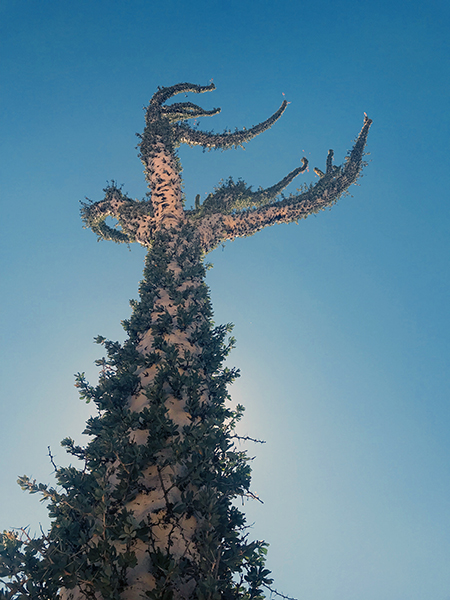
Before I reached Cataviña, I was zoning out a little, listening to my headphones to keep my mind off the endless rocky ascent heading southeast. Then I reached the top of that particular climb and literally gasped out loud, yanking my headphones out. The Cirios trees stretched across the valley. Almost exclusively found in Baja, they are like something Dr. Suess invented. Whimsical and welcoming with many wild, curving stems at the top, they resemble towering, spiraling cacti from a distance. The tiny leaves help retain water, a serious task for perennial plants in this environment, and the trunks taper, hence the name ‘cirio,’ Spanish for candle. I didn’t see or hear another soul for almost three days in this section, except at a small truck stop where I filled my water bladders.
Dodder
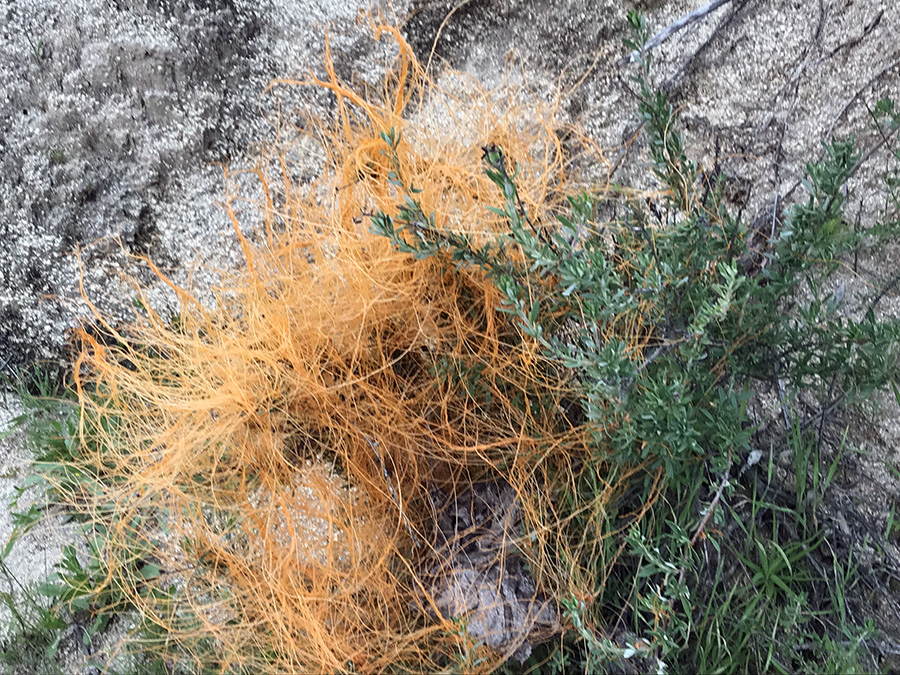
It took me a minute to realize that this plant was not desiccated twine carried by the breeze and snagged on a bush. This parasitic plant is made up of thread-like orange tendrils, and it tangles itself to attach to its host. There are 14 species found in Baja!
Elephant Cactus

Also commonly called Cardón, their Spanish name. There are one hundred and twenty species of cactus in Baja, but the Elephant Cactus, Pachycereus pringlei, is the largest and most well-known. With its huge size (it can reach up to 65 feet tall and weigh up to ten tonnes), and gnarled exterior, it’s easy to see how it earned its name. Imagine a Saguaro cactus the size of a small building. Most interestingly, it has a symbiotic relationship with the bacteria and fungi on its roots that help break up rocks so that the roots have somewhere to go. They are literally rock-busting plants! When Elephant Cactus reproduces, it stores the symbiotic bacteria in its seeds. So. Cool.
Fairy Duster
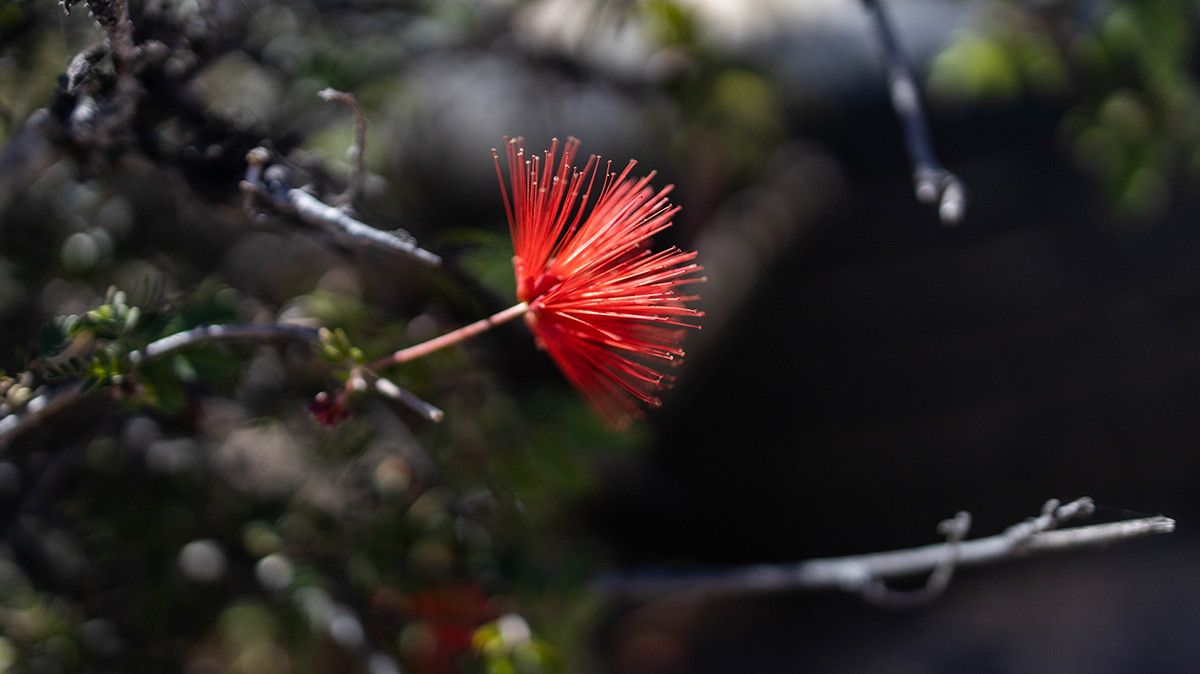
The Baja fairy duster is a native shrub, and the flowers have unique clusters of red stamens that look like feather plumes, hence its name. I saw this one quite a bit, since it loves sun and heat, and flowers from spring to fall. One particular morning I watched a hummingbird frolic around one, just outside of La Paz, as I began the Cape Loop.
Gumweed
The sticky green bracts at the base of the flower head are what gives these yellow beauties their common name, and yes, they can be chewed like gum! The gumweed I saw was Grindelia camporum, the Great Valley Gumplant, in the sage scrub area outside of San Diego, just after the official start of the Baja Divide route.
Hibiscus
There is a deep red cultivated variety of Hibiscus called “Baja Breeze,” which thrives in pots and gardens on the peninsula and beyond.
Ivyleaf Morning Glory
I mostly saw these enduring purple trumpets along roadsides. Like other aggressive morning glory vines, this one can spread pretty quickly. While it originates from tropical parts of the Americas, it is not in the ‘invasive’ category (usually reserved for plants that out-compete natives to a threatening degree).
Jojoba
A native shrub in Baja, its foliage provides food year round for deer, and its nuts are eaten by rabbits and larger birds. The oil inside the nut is also used in many cosmetic products.
Kingcup Cactus
Echinocereus coccineus. This red bloom with round petals emerging from green, spiny cacti is quite a delight in the desert!
Lupine
There are many lovely lupine species in Baja, but one commonly known as stinging lupine was memorable. The stem and leaves of Lupinus hirsutissimus have long, stiff hairs that sting skin when touched. I saw this prickly little beast as I climbed from Ojos Negros towards the Pacific Coast. The track in that section is rocky and steep as it nears the coast, making me wish I had a full suspension bike, if only for a moment. Because I promised my husband I would stay safe, I walked my rigid off-road touring bike down the slope, reveling in the Pacific Ocean views. It worked out, because when I walk I see even more plants.
Mallows

The cheery coral-orange heads of the globe mallow (genus Sphaeralcea) bobbed in meadows, and what delight they brought me! These little friends brought relief to an otherwise stressful day descending from El Coyote Ranch in the mountains into Vicente Guerrero. My brakes were malfunctioning and I was desperate to reach the bike shop in town after some scary descents. These little flowers reminded me that everything was going to be okay.
Narrowleaf Goldenbush
This shrub has bright yellow, showy flowers at the end of its stalks, and again accompanied me in the remote days before Cataviña, where rainbows of wildflowers bloom from March to May. Plants in this genus, Ericameria, are important for wildlife. The larvae of some butterfly species feed on them, as do rabbits, birds, and small mammals.
Ocotillo
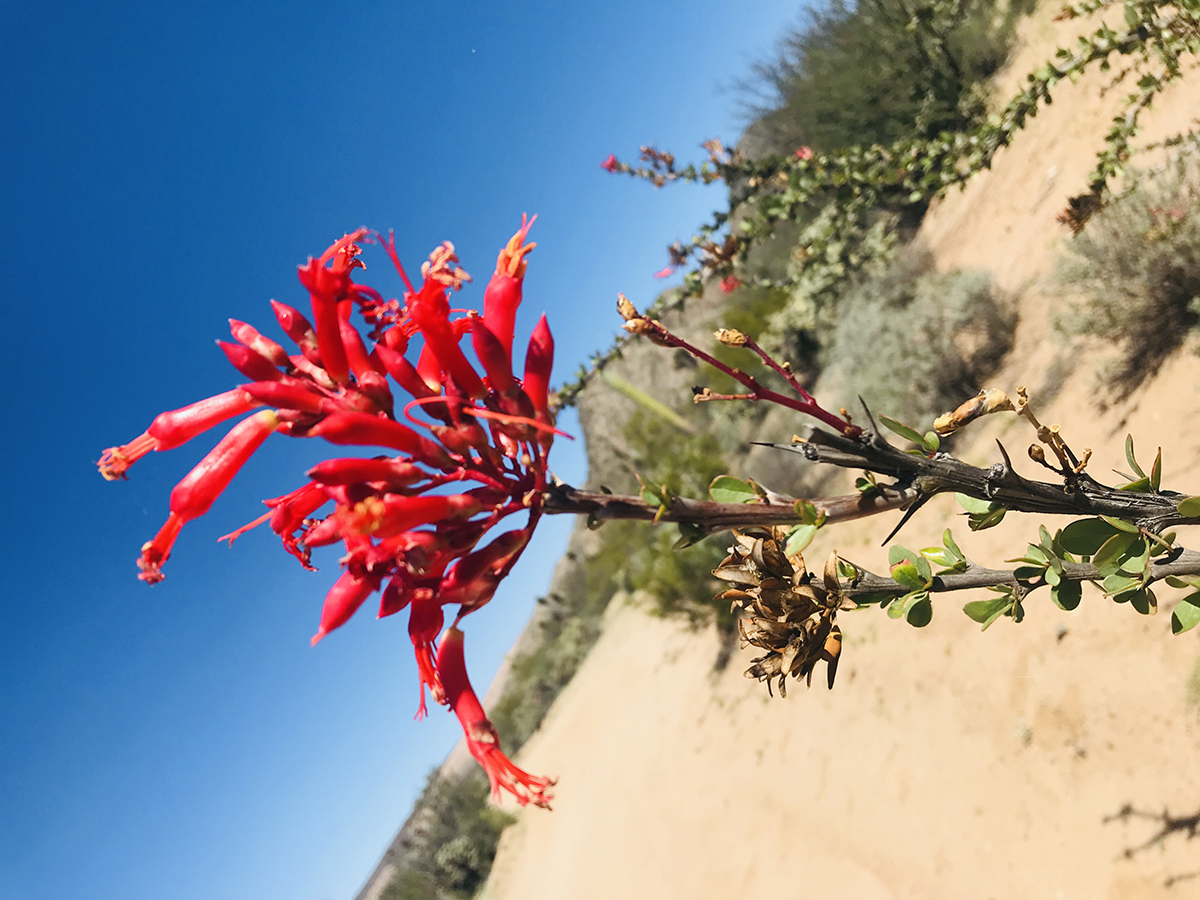
A mess of spindly, gothic, gray-green branches emanate from the base of these plants, and do not branch a second time. They are covered in massive triangular sharp spines and narrow oval leaves. They may lose and regrow leaves several times a year, depending on rainfall. When leafless, ocotillos rely on chlorophyll in their stems for photosynthesis. I saw their clusters of bright red flowers at all elevations within Baja, reminding me each time that “ocotillo” stems from the Náhuatl word ocotl, which means torch. They bloom from March to June, then might bloom again depending on rainfall.
Parry’s Phacelia

A tiny dot of rich royal purple stopped me mid-pedal stroke on my fourth day on the Baja Divide just outside of Uruapan, I believe in the traditional lands of the Pai Pai. It really stands out in the desert. Nestled in its native range of coastal and inland mountains and deserts, this hardy gem of purple thrives in a variety of habitats including coastal sage scrub, chaparral, and roadsides.
Quail Plant
There are many common names for Heliotropium curassavicum, probably because it grows from Canada to Argentina. Quail plant is also called salt heliotrope, which makes sense, since I saw it briefly in the salt flats east of San Quintín where I caught amazing tailwinds!
Rabbitbush
Native and very very abundant in Baja, if you see a bush with triangle-shaped leaves, it is likely Rabbitbush. Latin name: Ambrosia deltoidea.
Seaside Fiddleneck
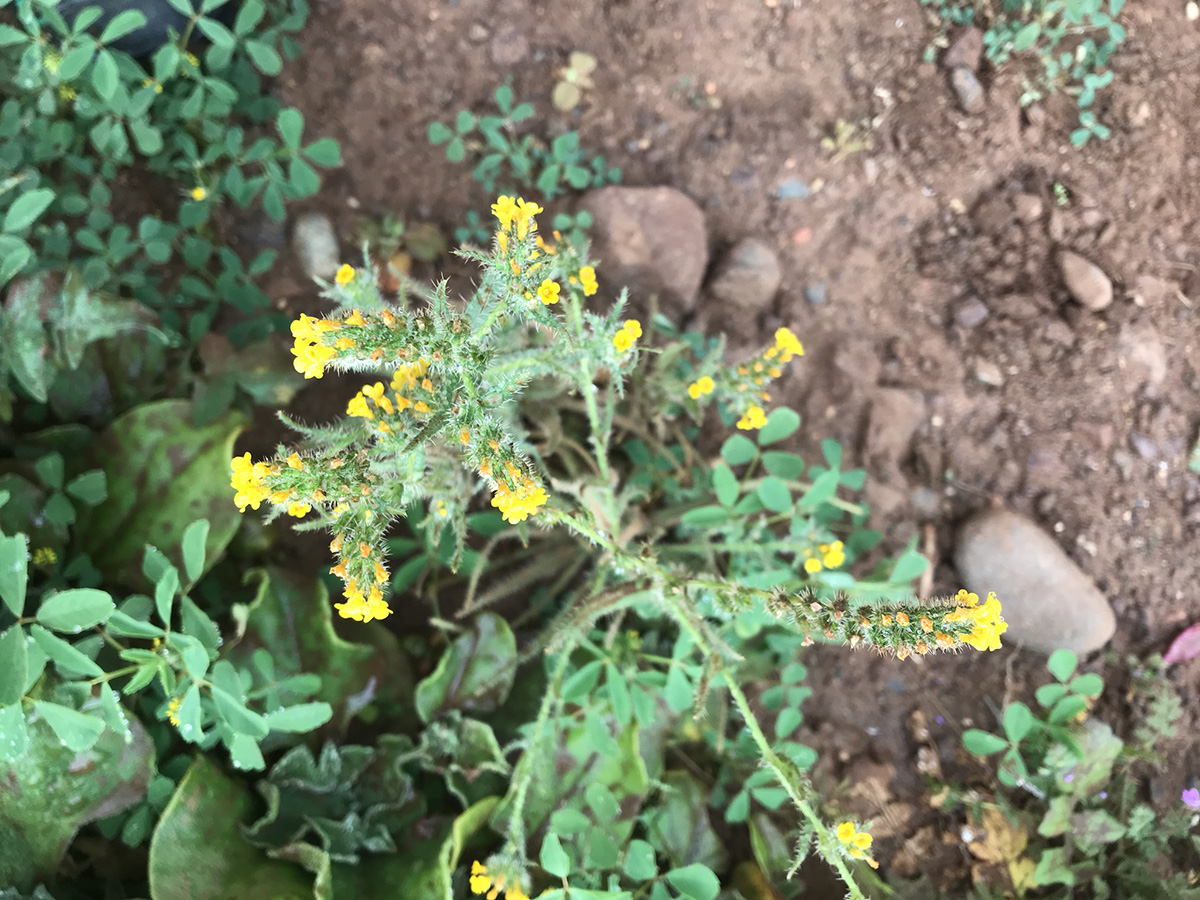
After a drizzly, sleepless night on a seaside cliff north of Erendira, I rolled into town and wolfed down the best chorizo, fresh salsa, potatoes, and eggs I have ever tasted. I went through my plant photos while Elvira, the incredible chef, insisted I take her photo with my bike. Five species of fiddleneck (genus Amsinckia) are found in Baja, and without a microscope, it’s hard to tell which one I saw just north of the small town. But given the sandy and rocky soil perched just above the Pacific, I’m willing to take a guess. The curling stems supported yellow flowers, and I’d say it’s likely the seaside fiddleneck, Amsinckia spectabilis.

Torote Blanco
The Spanish name for Elephant Tree. In the hills surrounding Cataviña, I dismounted my bike to investigate these trees shaped like swollen gourds. I learned that their thick, rounded trunks store water and resemble an elephant trunk, giving the plant its common name. There are actually two “elephant trees” endemic to Baja. One of them, Pachycormus discolor in the cashew family, has bark that becomes papery as it ages, falling off to reveal greenish photosynthetic tissues underneath. The other, more common Bursera microphylla is in the torchwood family, and is dormant in the winter. The sap of the Bursera also smells incredible, a mix between cedar, orange peels and pine.
Unicorn Plant
This magical sounding plant has pink and yellow flowers which bloom later in the year (April-October), so I didn’t get to see them on my March-April Baja foray. But I read about their “Double Claw,” seed pods, which split into two and curl into thin hooks, an adaptation that helps them disperse on the backs of passing animals, and on the socks of passing humans. In case you’re wondering, their Latin name is Proboscidea parviflora, which is pleasantly descriptive.
Verbena
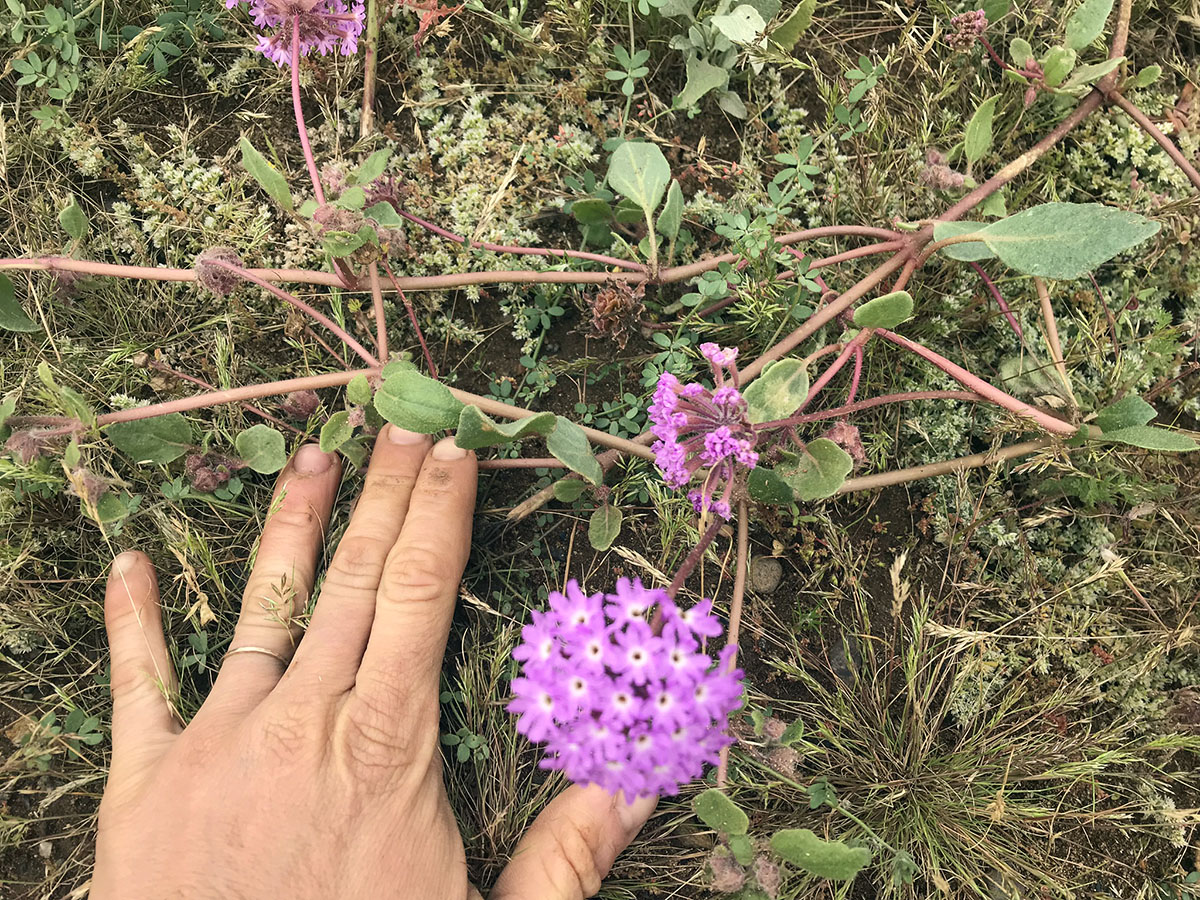
I saw these clusters of pink-purple flowers as I was grinding through mud from Vicente Guerrero to San Quintín. It is only 25 miles, but it took me all day, since I had to stop every 100 yards or so to clear out my drivetrain in order to move forward again. Despite the hardships, I appreciated the previous days’ rains, since it meant that the verbena (Abronia villosa, Desert Sand Verbena) had the plentiful winter rains needed to produce the carpet of flowers I was enjoying.
Walkingstick Cactus
This tangle of spines and branches is common, and is more representative of what to expect in Baja. This one is part of a group of cacti commonly referred to as chollas (pronounced “choy-ya”). This group is known for their cylindrical branches and spines that can tenaciously attach to your skin. Some cyclists carry extra strong tweezers in order to address an encounter with the spines, but I was lucky enough to pedal through unscathed.
Xanthisma spinulosum
More commonly known as the Lacy Tansyaster, their flowers with yellow center and yellow petals have proved to be confusing for botanists trying to classify them. There is no exception for this botanist, and among all the yellow Asteraceae flowers I did see over many hills and ridges and exhausted leg muscles, I am not sure if I saw these or not. But as far as I know, they do exist in Baja.
Yucca valida

More commonly called datilillo, it is often confused with the Joshua Tree. But Yucca valida is endemic to the peninsula, whereas Joshua Trees don’t live in Baja. Despite appearances, the Yuccas are not trees at all, and have trunks made of stringy fibers instead of wood. My early March arrival in Baja was perfect for the cream-colored blooms of the Yucca, which are arranged like elegant floral chandeliers in the middle of linear, sharp leaves splayed out.
Zauschneria
Zauschneria is one of the common names of Hummingbird Trumpet, Epilobium canum. I was too early for the long, narrow, bright orange-red blooms, which emerge in late summer, at the right time to provide nectar for migrating hummingbirds.
Nuts and Bolts
For the best up-to-date information on the Baja Divide, check out the route on bikepacking.com. There is a link to a folder containing the GPX of the route, waypoints, and other important information. I recommend joining the Facebook group, where folks share information in real time, such as recently-built fences, restaurant recommendations, dried up wells, or locked gates. It’s also nice to connect with others who might be on the route when you are.
There are sections that require you to carry ample water, so pack accordingly. The route is rugged and remote, so take spare parts, and be well-versed in fixing flats, or other mechanical issues particular to your bike. I would not recommend doing this route on tires with tubes or on a gravel bike, due to all the thorns, cactus, and sand. I pulled dozens of thorns out of my wide, tubeless tires, and never got a flat.
There is ample information on the website about which bike is best to take, but I recommend one with as wide of tires as you can get, close to 3”. A hardtail with bikepacking bags is ideal, but that might not be an option for you (It was not an option for me, since I had a lot of pavement miles after this section). I had a rigid Salsa Fargo which handled great, though the weight of my panniers sometimes pulled in unexpected directions on rough, rocky sections. The more weight you can have up front, and the closer you can put it to your frame, the better. Take a plant field guide if you can! The Baja Plant Field Guide by Rebman and Roberts is fabulous.

